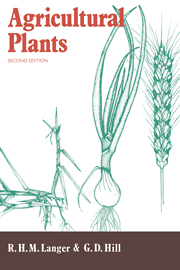Book contents
- Frontmatter
- Contents
- Preface to the first edition
- Preface to the second edition
- 1 World population and crop production
- 2 Plant structure
- 3 Liliaceae
- 4 Poaceae
- 5 Apiaceae
- 6 Asteraceae
- 7 Brassicaceae
- 8 Cannabinaceae
- 9 Chenopodiaceae
- 10 Cucurbitaceae
- 11 Fabaceae
- 12 Lamiaceae
- 13 Linaceae
- 14 Malvaceae
- 15 Papaveraceae
- 16 Solanaceae
- 17 Physiological basis of yield
- Index of specific names
- Subject index
11 - Fabaceae
Published online by Cambridge University Press: 05 June 2012
- Frontmatter
- Contents
- Preface to the first edition
- Preface to the second edition
- 1 World population and crop production
- 2 Plant structure
- 3 Liliaceae
- 4 Poaceae
- 5 Apiaceae
- 6 Asteraceae
- 7 Brassicaceae
- 8 Cannabinaceae
- 9 Chenopodiaceae
- 10 Cucurbitaceae
- 11 Fabaceae
- 12 Lamiaceae
- 13 Linaceae
- 14 Malvaceae
- 15 Papaveraceae
- 16 Solanaceae
- 17 Physiological basis of yield
- Index of specific names
- Subject index
Summary
After the Poaceae, the Fabaceae commonly known as legumes are the most important family of cultivated crop plants in both the tropical and temperate world. They also form a very large family comprising some 700 genera and 18 000 species, and in fact taxonomists have argued that, rather than being a single family, the legumes should be considered as an order divided into three families or that, at the very least, subfamilies should be recognised. Since we are not concerned here with taxonomic subtleties, we will for the sake of simplicity follow the second, and more universally accepted alternative. Of the three subfamilies in the Fabaceae two are of little interest in temperate regions and do not include plants of major economic significance. The first of these is the Mimosoideae, of which the wattles in Australia are a good example. In these plants the flowers are regular and tend to be massed together in large numbers to form conspicuous heads, with the stamens often forming the most visible feature. In the Caesalpinioideae the flowers are zygomorphic, that is their shape is irregular, and in particular the position of the uppermost petal differs from that in the other groups of legumes. This subfamily is also of tropical distribution and of little economic significance. The largest subfamily, and by far the most important in terms of agricultural production is the Faboideae (also called Papilionoideae or Lotoideae) which consists of nearly 500 genera containing 12000 species. Their distribution is worldwide and the plants range from large trees to small annual herbs.
- Type
- Chapter
- Information
- Agricultural Plants , pp. 217 - 282Publisher: Cambridge University PressPrint publication year: 1991
- 1
- Cited by



